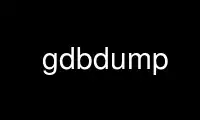
This is the command gdbdump that can be run in the OnWorks free hosting provider using one of our multiple free online workstations such as Ubuntu Online, Fedora Online, Windows online emulator or MAC OS online emulator
PROGRAM:
NAME
gdbdump - dump HP 100LX database into ASCII format
SYNOPSIS
gdbdump [-noqswm] file
DESCRIPTION
gdbdump exports the contents of an HP 100LX database into an ASCII form. file is the name
of the 100LX database to read; the results are written to the terminal and can be
redirected or piped as needed. The output format is suitable for input to many database
packages as well as to gdbload(1).
Options
gdbdump recognizes the following options:
-n Suppress the first line of the output, which normally contains the names of
all of the database fields. Note that if this option is specified, the
output is not compatible with gdbload(1). However, this option may be
needed for compatibility with other database programs trying to read the
output.
-o Omit note fields from the output. Note fields are included by default.
-q Suppress warning messages.
-s Write special characters (character codes 128-254, inclusive) directly to
the output. The default is to represent such characters in \nnn notation.
-w Wrap long lines. For some databases, the output line length can be larger
than some programs (notably vi(1)) can handle, especially if records contain
long notes. This option wraps each output line at about 75 characters,
marking the end of lines to be continued with a backslash (\). gdbload(1)
understands this format.
-m Write multi-line string (i.e. note) fields on multiple lines. Thus the
quoted string will span newlines. Without this option, newlines in strings
will be output as \r\n sequences, and the complete string will be subject to
line wrapping if specified by the -w option.
Output Format Description
The output of this program is an ASCII text file which starts with a line containing field
names (unless -n was specified) and is followed by one line for each record of the
database. Note that any of these lines may be split into multiple lines if -w is
specified, and that newlines in strings may cause further splitting if specified by the -m
option. Each "logical" line contains all of the fields of the database, in the same order
in which their field names appeared on the first line of the output. The fields are
separated by commas.
Exactly how each field appears in the output depends on its type. Text fields, category
fields, and note fields appear with the contents inside quote marks ("). Quote marks and
backslashes within the text of the field are escaped by preceding them with a backslash
(\). Newlines are printed as \n and carriage returns as \r, unless the -m option is used.
Non-printing or non-ASCII characters as \nnn, where nnn is an octal character code. (See
the description of the -s flag, above.)
Number fields appear as they do in the database. Date fields appear in the format
YYYYMMDD; for example, August 15, 1993 would appear as 19930815. Time fields appear in
the format HHMM, where HH is in the range 00-23.
Radio buttons and check boxes appear as 1 if selected, 0 otherwise.
All other field types, including application-defined types, are omitted from the output.
This output format can be used as input to gdbload(1).
WARNINGS
gdbdump cannot handle the application-defined records and fields in HP 100LX Appointment
Book and World Time databases. Running this program on such databases will give useful,
but incomplete, output.
Records are printed in the order stored in the file, i.e., randomly.
This program cannot handle password-protected databases. Attempts to dump password-
protected databases will have unpredictable results.
Use gdbdump online using onworks.net services
